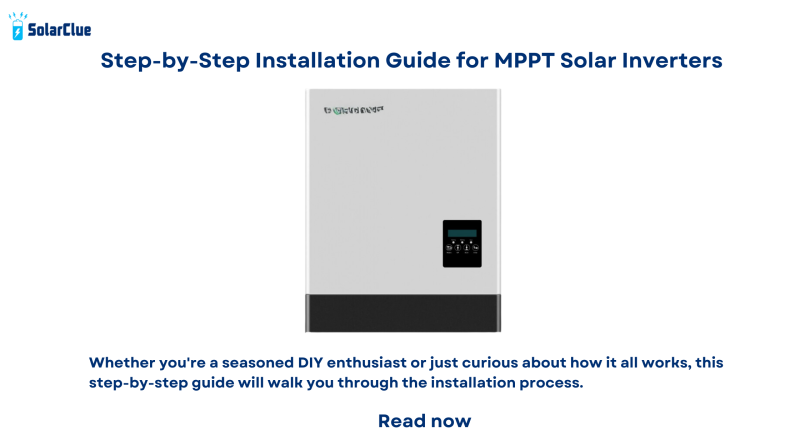Step-by-Step Installation Guide for MPPT Solar Inverters
Are you ready to dive into world of MPPT Solar Inverters ? This is a fantastic way to harness solar power efficiently and save on your electricity bills. Whether you’re a seasoned DIY enthusiast or just curious about how it all works, this step-by-step guide will walk you through the installation process. By the end of this guide, you’ll feel confident about setting up your new solar system. Let’s get started!
Table of Contents
- 1 What is an MPPT Solar Inverter?
- 1.1 Step 1: Gather Your Tools and Materials
- 1.2 Step 2: Choose the Right Location
- 1.3 Step 3: Mount the Inverter
- 1.4 Step 4: Install the DC Disconnect Switch
- 1.5 Step 5: Connect the Solar Panels
- 1.6 Step 6: Wire the Inverter
- 1.7 Step 7: Install the AC Disconnect Switch
- 1.8 Step 8: Connect to Your Home’s Electrical System
- 1.9 Step 9: Grounding
- 1.10 Step 10: Final Checks and Power Up
- 1.11 Step 11: Monitor and Test
What is an MPPT Solar Inverter?
Before we dive into the installation process, let’s quickly cover what an MPPT solar inverter actually is, MPPT stands for Maximum Power Point Tracking. This smart device takes the DC power generated by your solar panels and converts it into AC power that your home can use. The “MPPT” part means it’s extra efficient at squeezing the most power possible out of your panels, even when conditions aren’t perfect.
Now, let’s get into main point of installation!
Step 1: Gather Your Tools and Materials
First things first, you’ll need to make sure you have everything you need. Here’s a list of the essentials:
– Your MPPT solar inverter
– Solar panels
– Mounting brackets
– DC disconnect switch
– AC disconnect switch
– Circuit breaker
– Electrical wires (both DC and AC)
– Conduit for protecting the wires
– Screwdrivers (flathead and Phillips head)
– Wire strippers
– Voltage tester
– Drill and drill bits
– Level
– Safety gear (gloves, safety glasses, etc.)
Make sure you have all these items before you start. There’s nothing worse than getting halfway through a project and realizing you’re missing a crucial piece!
Step 2: Choose the Right Location
Picking the perfect spot for your inverter is super important. Here are some things to keep in mind:
– Keep it close to your main electrical panel to minimize wire runs
– Make sure it’s in a cool, dry place (avoid direct sunlight and moisture)
– Leave enough space around it for air circulation (check the manual for specific requirements)
– Mount it at eye level for easy access and monitoring
– Ensure the wall can support the weight of the inverter
A garage or utility room often works well, but every home is different. Take your time to find the best spot.
Step 3: Mount the Inverter
Now it’s time to get that inverter up on the wall! Here’s how:
- Use your level to draw a straight line where you want the top of the inverter to be.
- Mark the spots for your mounting holes (your inverter should come with a template to make this easier).
- Drill pilot holes for your mounting screws or anchors.
- Attach the mounting bracket to the wall.
- Carefully lift the inverter and hang it on the bracket.
- Secure the inverter to the bracket following the manufacturer’s instructions.
Remember, these things can be heavy, so don’t be shy about asking for help if you need it!
Step 4: Install the DC Disconnect Switch
The DC disconnect switch is a safety feature that allows you to cut off power from the solar panels to the inverter. Here’s how to install it:
- Choose a spot close to the inverter, but still easily accessible.
- Mount the DC disconnect switch box to the wall.
- Run conduit from the solar panels to the DC disconnect switch.
- Pull the wires from the solar panels through the conduit and into the switch box.
- Connect the wires to the switch according to the manufacturer’s instructions.
- Run conduit from the DC disconnect switch to the inverter.
- Pull wires through this conduit, leaving enough slack to make connections later.
Step 5: Connect the Solar Panels
Now it’s time to link up those solar panels:
- Make sure the panels are covered or it’s a cloudy day to minimize live current.
- Connect the positive and negative wires from each panel in series or parallel, depending on your system design.
- Run these combined wires to your DC disconnect switch.
- Double-check all connections are tight and secure.
Step 6: Wire the Inverter
This is where the magic happens – connecting your inverter to both the DC input and AC output:
- Open up the wiring compartment of your inverter.
- Connect the DC wires coming from the disconnect switch to the DC input terminals of the inverter. Make sure to match positive and negative correctly!
- Connect AC wires to the AC output terminals of the inverter.
- If your inverter has a grounding terminal, connect it to your home’s grounding system.
- Double-check all connections are secure and properly insulated.
Step 7: Install the AC Disconnect Switch
Similar to the DC switch, the AC disconnect allows you to cut power between the inverter and your home’s electrical system:
- Mount the AC disconnect switch near your main electrical panel.
- Run conduit from the inverter to this switch.
- Pull the AC wires from the inverter through the conduit and into the switch box.
- Connect these wires to the switch.
- Run conduit from the AC disconnect to your main electrical panel.
Step 8: Connect to Your Home’s Electrical System
This is the part where you’ll definitely want to consider calling in a professional electrician if you’re not 100% confident:
- Turn off the main power to your house at the electrical panel.
- Run the wires from your AC disconnect switch into the electrical panel.
- Connect these wires to a new dedicated circuit breaker.
- Install this new breaker in your electrical panel.
- Label the new breaker clearly as your solar input.
Step 9: Grounding
Proper grounding is crucial for safety:
- Connect a grounding wire to the grounding terminal on your inverter.
- Run this wire to your home’s main grounding rod or grounding system.
- Ensure all metal parts of the system (panels, racks, etc.) are properly grounded too.
Step 10: Final Checks and Power Up
You’re almost there! Before you flip the switch:
- Double-check all your connections one last time.
- Make sure all switches are in the “off” position.
- Uncover your solar panels if they were covered.
- Turn on the DC disconnect switch.
- Turn on the inverter.
- Turn on the AC disconnect switch.
- Finally, turn on the new breaker in your electrical panel.
If all goes well, you should see your inverter light up and start working its magic!
Step 11: Monitor and Test
Over the next few days, keep a close eye on your new system:
- Check the inverter display regularly to ensure it’s producing power.
- Listen for any unusual noises.
- Monitor your electric bill to see your savings in action!
Conclusion
And there you have it! You’ve successfully installed your MPPT solar inverter. Give yourself a pat on the back – you’ve just taken a big step towards energy independence and a greener future.
Remember, while this guide gives you a good overview of the process, every system is a bit different. Always refer to your specific inverter’s manual for detailed instructions. And if at any point you feel unsure or uncomfortable, don’t hesitate to call in a professional. It’s always better to be safe than sorry when dealing with electrical systems.
I hope this guide has made the installation process feel a bit less intimidating. Solar power is an amazing technology, and it’s exciting to see more and more people embracing it. As you watch your meter run backwards and your energy bills shrink, I think you’ll agree it was worth the effort.
So, are you ready to start soaking up that sun? With your new MPPT solar inverter, you’re all set to turn those rays into savings. Happy solar powering, and here’s to a brighter, cleaner energy future!
Visit SolarClue® to see the best MPPT Solar Inverters. SolarClue® actively sells solar energy products at discounts of up to 50% on its online marketplace.



